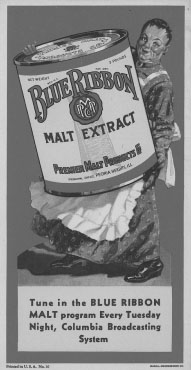Malt Syrup or extract is the concentrated (or it can also be dried) form of unfermented brewery wort. Malt syrup is generally produced as a viscous, sticky liquid. Its flavor is, not surprisingly, malty, but distinctly so because of the concentration process during manufacture. Apart from its use in brewing, it is also widely used in baking, confectionery, breakfast cereals, malt beverages, dairy products, and condiments and as a caramel substitute.
The production process through milling, mashing, mash separation, and wort boiling is similar to that of conventional beer production. Depending on the color and flavor attributes desired by the manufacturer, the grist used to produce malt extract will have similar proportions of pale malt and varying proportions of specialty malts (i.e., crystal, chocolate, black, etc.) that are used to produce pale colored lagers and pilsners/pils through darker colored ales to the more intensely colored porters and stouts. The attendant flavor characteristics of these beer styles will also accompany the malt extract produced. These malts are milled and mashed similarly to the normal brewing process. Mash separation is ideally achieved using a mash filter rather than a traditional lauter tun because wort can be recovered at higher gravities (i.e., ∼30°P compared with ∼20°P, respectively), which saves considerable amounts of energy and attendant cost in the concentration phase. The wort is generally boiled (adding to concentration) and it may be hopped or unhopped depending on the intended use of the product. After this point the wort will be evaporated to approximately 80% solids to produce a thick, viscous liquid or in some cases spray dried to a powdered form. Finally, the malt syrup will be aseptically packaged and then stored and distributed.

Ink blotter, c. 1920. During Prohibition, the Pabst Brewing Company began selling malt extract as an alternative revenue source. pike microbrewery museum, seattle, wa
Malt syrup is just the concentrated product of the prefermentation; thus, the relative proportions of the various wort components are similar to the wort from which it is derived. Based on a syrup containing 80% solids, the level of protein and free amino nitrogen would be approximately 0.5% and 0.15%, respectively, by weight. The syrup will also contain the appropriate levels of trace elements (i.e., zinc, iron, manganese, potassium, calcium, copper, magnesium), vitamins (i.e., biotin), and lipids (“oils”) to enable yeast growth and sustain its metabolism. The syrup is rich in maltose that comprises 60%–70% of the fermentable sugars.
Most homebrewers will be familiar in at least their initial, and often continuing, brewing activities with malt extract that is conveniently provided in a can. Extract brewing avoids the time-consuming and equipment-intensive prefermentation stages of the brewing process. For homebrewing the malt syrup is diluted with hot water to the required gravity, heated (and hopefully boiled, except with some rather lackluster “one-step” kits) to ensure solubilization and sterilization of the wort, and cooled, with yeast being pitched to ferment the wort. For more experienced homebrewers, the addition of various adjuncts, specialty syrups, steeped grains, and different hops provides the opportunity to personalize their beer production.
Malt extracts for brewing are provided to commercial and homebrewers in an increasingly large range of different styles and formulations. In addition to the traditional “standard” (read ale) light and dark malt syrups, more exotic and exciting concoctions such as wheat, Munich, amber, crystal, Carapils, roast malt, etc. are also being produced. Mixing varying proportions of these extracts essentially allows home and professional brewers alike to formulate most of the established range of beer styles. In addition, some malt syrups have various levels of diastatic power enzymes, retained or added, so the unmalted starch adjuncts can also be added and utilized during brewing.
Commercial brewers have also found uses for malt extracts. Some brewers use them as a suitable substrate for yeast propagation when the brewery’s own worts are unsuitable or unavailable. Not surprisingly, given the cost of capital startup or because of franchising constraints, some microbrewers and brewpubs also rely on malt syrups and special additions of hops, etc., to produce their beers. Even larger commercial brewing groups have found uses for malt syrups. For instance, in the quest to produce low-alcohol beers that have a palate similar to that of full-strength beer, some brewers include a proportion of maltodextrin syrups that have low fermentability to retain mouthfeel while controlling alcohol content and color. Additionally, the use of specialist malt syrups by small to medium-size breweries can be simply used to diversify the standard wort being produced into a number of different beer styles. This can be relatively easily achieved by blending in the appropriate proportion of specialty malt syrup—such as chocolate malt—for making a stout or porter.
